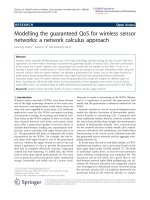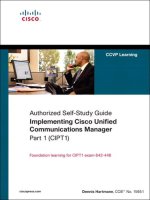Cisco press qos for IP MPLS networks jun 2006 ISBN 1587052334
Bạn đang xem bản rút gọn của tài liệu. Xem và tải ngay bản đầy đủ của tài liệu tại đây (4.3 MB, 514 trang )
QoSforIP/MPLSNetworks
BySantiagoAlvarez
...............................................
Publisher:CiscoPress
PubDate:June02,2006
PrintISBN-10:1-58705-233-4
PrintISBN-13:978-1-58705-233-0
Pages:336
TableofContents|Index
ThecomprehensiveguidetoimplementingQoSinmultiservicenetworksusingIP/MPLS
UnderstandthetechnologycomponentsofimplementingQoSinamultiservice
network
LearnhowtoconfiguretheMPLSQoSfunctionalityinCiscoIOS--configurationdetails
helpyoudeployQoSinyournetwork
DesignoptimalnetworkswithconfidencethroughknowledgeofmultipleQoSdesign
options
UnderstandthemarketpotentialofservicedifferentiationusingQoS
QualityofService(QoS)playsakeyroleintheimplementationofmultiserviceand
convergednetworks.Industryeffortstoachieveconvergencehavegeneratedaneedfor
increasedlevelsoftrafficdifferentiation.AnarrayofQoSrequirementsneedtobemetto
supportdistinctapplications(e.g.voice,video,anddata)andmultiplenetworkservices
(e.g.IP,Ethernet,ATM)onasingleconverged,multiservicenetwork.Therefore,QoShas
becomeanintegralpartofanmultiservice,convergednetworkandservice
implementation.QoSforIP/MPLSNetworksoffersnetworkarchitectsandengineersa
singlesourceofinformationforthedesign,deployment,andimplementationofQoSenabledservicesonanMPLSnetworkusingCiscoIOS.Readerswillgainknowledgeofthe
technologybehindMPLSQoSandrelatedtechnologiesandwilllearnthedifferentdesign
optionsavailabletobuildamultiserviceMPLSnetwork.Thebookcoversindetailthe
behaviorandconfigurationoftherichMPLSQoSfunctionalityinCiscoIOS.Itisasolid
referenceofworkingconfigurationexamples,butdoesnotintendtobeacommand
referenceonthesubject.
QoSforIP/MPLSNetworks
BySantiagoAlvarez
...............................................
Publisher:CiscoPress
PubDate:June02,2006
PrintISBN-10:1-58705-233-4
PrintISBN-13:978-1-58705-233-0
Pages:336
TableofContents|Index
Copyright
AbouttheAuthor
AbouttheTechnicalReviewers
Acknowledgments
IconsUsedinThisBook
Foreword
Introduction
Chapter1.QoSTechnologyOverview
IPQoSArchitectures
MPLSSupportforIntServ
MPLSSupportforDiffServ
Traffic-ManagementMechanisms
QoSSignaling
Summary
References
Chapter2.MPLSTETechnologyOverview
MPLSTEIntroduction
BasicOperationofMPLSTE
DiffServ-AwareTrafficEngineering
FastReroute
Summary
References
Chapter3.CiscoQoS
CiscoQoSBehavioralModel
ModularQoSCommand-LineInterface
Summary
References
Chapter4.CiscoMPLSTrafficEngineering
BasicOperationofMPLSTE
DiffServ-AwareTrafficEngineering(DS-TE)
FastReroute(FRR)
Summary
References
Chapter5.BackboneInfrastructure
BackbonePerformance
LatencyVersusLinkUtilization
ReferenceNetwork
QoSDesignAlternatives
DiffServBackbonewithMPLSTE
Summary
References
AppendixA.CommandReferenceforCiscoMPLSTrafficEngineeringandRSVP
MPLSTECommands
EXECCommands
showCommands
clearCommands
debugCommands
RSVPCommands
showCommands
clearCommands
debugCommands
Index
Copyright
QoSforIP/MPLSNetworks
SantiagoAlvarez
Copyright©2006CiscoSystems,Inc.
Publishedby:
CiscoPress
800East96thStreet
Indianapolis,IN46240USA
Allrightsreserved.Nopartofthisbookmaybereproducedor
transmittedinanyformorbyanymeans,electronicor
mechanical,includingphotocopying,recording,orbyany
informationstorageandretrievalsystem,withoutwritten
permissionfromthepublisher,exceptfortheinclusionofbrief
quotationsinareview.
PrintedintheUnitedStatesofAmerica1234567890
FirstPrintingJune2006
LibraryofCongressCataloging-inPublicationNumber:2004117089
TrademarkAcknowledgments
Alltermsmentionedinthisbookthatareknowntobe
trademarksorservicemarkshavebeenappropriately
capitalized.CiscoPressorCiscoSystems,Inc.cannotattestto
theaccuracyofthisinformation.Useofaterminthisbook
shouldnotberegardedasaffectingthevalidityofany
trademarkorservicemark.
WarningandDisclaimer
Thisbookisdesignedtoprovideinformationaboutqualityof
serviceinIP/MPLSnetworksusingCiscoIOSandCiscoIOSXR.
Everyefforthasbeenmadetomakethisbookascompleteand
asaccurateaspossible,butnowarrantyorfitnessisimplied.
Theinformationisprovidedonan"asis"basis.Theauthors,
CiscoPress,andCiscoSystems,Inc.shallhaveneitherliability
norresponsibilitytoanypersonorentitywithrespecttoany
lossordamagesarisingfromtheinformationcontainedinthis
bookorfromtheuseofthediscsorprogramsthatmay
accompanyit.
Theopinionsexpressedinthisbookbelongtotheauthorand
arenotnecessarilythoseofCiscoSystems,Inc.
CorporateandGovernmentSales
CiscoPressoffersexcellentdiscountsonthisbookwhen
orderedinquantityforbulkpurchasesorspecialsales.
Formoreinformationpleasecontact:U.S.Corporateand
GovernmentSales1-800-382-3419
ForsalesoutsidetheU.S.pleasecontact:InternationalSales
FeedbackInformation
AtCiscoPress,ourgoalistocreatein-depthtechnicalbooksof
thehighestqualityandvalue.Eachbookiscraftedwithcare
andprecision,undergoingrigorousdevelopmentthatinvolves
theuniqueexpertiseofmembersfromtheprofessional
technicalcommunity.
Readers'feedbackisanaturalcontinuationofthisprocess.If
youhaveanycommentsregardinghowwecouldimprovethe
qualityofthisbook,orotherwisealterittobettersuityour
needs,youcancontactusthroughe-mailat
Pleasemakesuretoincludethe
booktitleandISBNinyourmessage.
Wegreatlyappreciateyourassistance.
Publisher
PaulBoger
CiscoRepresentative
AnthonyWolfenden
CiscoPressProgramManager
JeffBrady
ProductionManager
PatrickKanouse
DevelopmentEditor
JillBatistick
SeniorProjectEditor
SanDeePhillips
CopyEditor
KeithCline
TechnicalEditors
MarkGallo,RaymondZhang
BookandCoverDesigner
LouisaAdair
Composition
MarkShirar
Indexer
KeithCline
Dedications
Thanksforwithstandinglong,longworkinghours.
AbouttheAuthor
SantiagoAlvarez,CCIENo.3621,isatechnicalmarketing
engineeringforCiscoSystemsworkingonMPLSandQoSsince
2000.HejoinedCiscointheblazingdaysof1997.Priorto
Cisco,SantiagoworkedinsoftwaredevelopmentforLucent
Technologies.Hehasbeeninvolvedwithcomputernetworking
since1991.SantiagoisafrequentspeakeratCiscoNetworkers
andaperiodiccontributortoCiscoPacketMagazine.Heholdsa
bachelorofsciencedegreeincomputersciencefromEAFIT
University,amasterofSciencedegreeincomputersciencefrom
ColoradoStateUniversity,andamasterofsciencein
telecommunicationsfromtheUniversityofColoradoatBoulder.
Outsidework,heenjoystheoutdoors,finefood,andexploring
theworldasanindependenttraveler.Hecanbereachedat
AbouttheTechnicalReviewers
MarkGalloisasystemsengineeringmanageratCisco
Systemswithinthechannelsorganization.Hehasledseveral
engineeringgroupsresponsibleforpositioninganddelivering
Ciscoend-to-endsystems,aswellasdesigningand
implementingenterpriseLANsandinternationalIPnetworks.He
hasaB.S.degreeinelectricalengineeringfromtheUniversity
ofPittsburghandholdsCiscoCCNPandCCDPcertifications.
MarkresidesinnorthernVirginiawithhiswife,Betsy,andson,
Paul.
RaymondZhangisaseniornetworkarchitectforBTInfonetin
theareasofGlobalIPbackboneinfrastructure,routing
architecturedesign,planning,anditsevolutions.Currently,his
mainareasofinterestincludelarge-scalebackbonerouting,
trafficengineering,performanceandtrafficstatisticalanalysis,
andMPLS-relatedtechnologies(includinginterdomaintraffic
engineering,GMPLS,metroEthernet,Diffserve,IPv6,and
Multicast).RaymondparticipatesinseveralIETFdraftsrelating
toMPLS,BGP-basedMPLSVPN,Inter-ASTE,and,more
recently,PCE-basedwork.
Acknowledgments
IwouldliketogivespecialthankstoBobOlsenandSandeep
Bajajforsharingtheirtechnicalexpertisethroughsomany
years.Theyhavepatientlytoleratedmyconstantinterruptions
andhaveprovidedusefulinsightondifferenttopicsincludedin
thebook.
Specialthankstothereviewers,MarkGalloandRaymond
Zhang.Iappreciateyourdetailedcomments.Iamtoblamefor
anyremaininginaccuraciesoromissions.
BigthankstoBruceDavie,whoseresponsivenessatkeypoints
encouragedmetopersistinmygoal.Ihighlyregardhis
unusualabilitytoabstractcomplexityandclearlyillustratethe
essenceofintricatetechnologyconcepts.Muchofhisworkhas
directlyandindirectlyinfluencedthecontentofthisbook.
Similarly,IextendmygratitudetoFranÁoisLeFaucheurand
JeanPhilippeVasseur.Theyhavehadthepatiencetodiscuss
withmemanyaspectsofthesetechnologiesinnumerous
occasions.Merci!
ThankstoRameshUppiliforcontributingtothepresentationof
keytopicsinmultipleways.
IalsowanttothankRakeshGandi,PrashanthYelandur,Ashish
Savla,BobbyKaligotla,LawrenceWobker,AshokGanesan,Jay
Thontakudi,andScottYowforfacilitatingthediscussionofCisco
IOSXRinthisbook.
SpecialthankstotheCiscoPressteam:JohnKane,Chris
Cleveland,JillBatistick,SanDeePhillips,andElizabeth
Peterson.Ireallyappreciateyourattentiontodetailand
extraordinarypatiencewithme.IwishJohnthebestinhisnew
endeavors.
Finally,ifyouhavereadthisfarinsearchofyourname,this
paragraphisforyou.Ihavetoacknowledgethatnumerous
individualscontributedthroughinsightfuldiscussions.They
unhappilyormaybehappilyremainanonymous.Thanks!
IconsUsedinThisBook
[Viewfullsizeimage]
CommandSyntaxConventions
Theconventionsusedtopresentcommandsyntaxinthisbook
arethesameconventionsusedintheIOSCommandReference.
TheCommandReferencedescribestheseconventionsas
follows:
Boldfaceindicatescommandsandkeywordsthatare
enteredliterallyasshown.Inactualconfigurationexamples
andoutput(notgeneralcommandsyntax),boldface
indicatescommandsthataremanuallyinputbytheuser
(suchasashowcommand).
Italicsindicateargumentsforwhichyousupplyactual
values.
Verticalbars(|)separatealternative,mutuallyexclusive
elements.Note,however,thattheverticalbar(pipe
operand)isalsousedtofiltercommand-lineinterface
commandoutput;inthatscenario,theoperand(|)precedes
thebegin,exclude,orincludekeywords,whicharethen
followedbyaregularexpression.
Squarebrackets[]indicateoptionalelements.
Braces{}indicatearequiredchoice.
Braceswithinbrackets[{}]indicatearequiredchoice
withinanoptionalelement.
Foreword
Thephrase"IPQoS"wasformanyyearsconsideredan
oxymoron.Indeed,muchofthesuccessoftheIParchitecture
couldbetracedtoitsadoptionofa"besteffort"servicemodel,
enablingIPtorunoverjustaboutanyunderlyingnetwork
technology.Besteffortservice,however,isdefinedbyalackof
assurancethatpacketswillbedeliveredinatimelymanner,or
evendeliveredatall.Suchaservicemodellimitsthepotential
ofIPnetworkstosupportapplicationsthatdemandtimely
packetdelivery,suchasinteractivetelephonyandmultimedia
applications.
Asfarbackas1979,therewereproposalstoextendtheIP
servicemodeltosupportapplicationswithstrongerQoS
requirements.However,thisremainedaresearchtopicuntilthe
early1990s.Bythatpoint,theideaofconvergencecarrying
manyapplicationswithdiverseQoSneedsonasingle
networkwasgainingcurrency,althoughtheword"convergence"
wouldnotbecomeabuzzwordforseveralyears.ATMwas
widelyexpectedtobethepacketswitchingtechnologythat
wouldenablethisconvergence,butaconcertedefforttoadd
QoStoIPwasalsogettingunderway.Theseminal1992paper
byClark,Shenker,andZhangonsupportofreal-time
applicationsintheInternetputaseriousstakeinthegroundfor
IPQoS,andworkattheIETFtostandardizeasetofIPQoS
mechanismsbeganshortlythereafter.TheIntegratedServices
architectureandResourceReservationProtocolresulted,and
theDifferentiatedServicesarchitecturefollowed.
AnothertechnicaldevelopmentwithbigimplicationsforIPQoS
wasMultiprotocolLabelSwitching,whichgrewoutofworkon
TagSwitchingatCiscobegunin1996.Therewasconsiderable
confusionaboutexactlywhatimpactMPLSwouldhaveonIP
QoS,inpartbecauseoftheresemblancesbetweenMPLSand
ATM,whichhaditsownQoSmodel.Inreality,thebiggestsingle
effectMPLShadonQoSwastoaddanothertooltotheQoS
toolbox,intheformoftrafficengineeringwithconstraint-based
routing.ItisforthisreasonmorethananyotherthatMPLSand
QoSdeservetobecoveredinasinglebook.
Whichbringsustothecurrentvolume.IPQoScannowbe
consideredamaturetechnology,notjustsomethingforthe
bleedingedge.Itisalsonotoriouslycomplextounderstandand
toconfigurecorrectly.Someofthiscomplexityisintrinsic;some
isanaccidentofhistory.Ontheintrinsicside,understanding
QoSishardbecauseitrequirestheabilitytooperateatmany
differentlevelsofabstraction.Oneneedstounderstandthe
highlevelQoSarchitectures,tohaveabehavioralmodelofQoS
featuresinsidearouter,toknowhowthosefeaturesmapontoa
particularpieceofhardware,andtounderstandtheCLIthatis
usedtocontrolthosefeatures.Thisiswherethisbooksets
itselfapartfromthepackofQoSbooks.SomecoverQoS
architectureandIETFstandards.Someprovideinformationon
CLIcommands.ButthisistheonlybookI'vefoundthatwalks
thereaderthroughthelevelsofabstractionfromhighlevel
architecturetolowlevelCLI,withaclearexplanationofthe
abstractQoSbehaviormodelthatallrouterssupportproviding
thebridgebetweenthelevels.Byreadingthisbook,youwill
understandboththebigpictureofQoSandthedetails
necessarytodeployitinarealnetwork.
AnotherfactorthatmadeQoSdifficulttomanageinthepast
wasasomewhatadhocapproachtoitsimplementation.
Combinationsoffeaturesweresometimesimplementedina
monolithicway,andinconsistencyacrossplatformswasthe
norm.Thissituationhasimprovedmassivelyinrecentyears,
notablywiththeadoptionoftheModularQoSCLIacrossmost
oftheCiscoproductline.Thus,QoSdeploymentismuchmore
straightfowardthanitoncewas,andthisbook'stimely
coverageoftheMQCanditsunderlyingbehavioralmodelwill
makeiteveneasier.
Manyreadersmaybetemptedtojumpstraighttothelast
chapter'sguidanceonhowtodesignanddeployaQoSstrategy
inabackbonenetwork.Santiago'sextensivereal-world
deploymentexperiencecertainlymakesthischapterespecially
valuable.However,theprecedingfourchaptersaretheones
thatwillprovideyouwithafundamentalunderstandingofQoS.
Thus,ratherthanblindlyfollowingaQoS"recipe,"you'llbeable
tomaketherightdesigndecisionstomeettheneedsofyour
ownapplicationsandcustomers.Ifyoureallywantto
understandQoSfully,thisisthebooktoread,fromstartto
finish.
BruceDavie
CiscoFellow
Introduction
Themotivationbehindthisbookisthecontinuedinterestinthe
implementationofqualityofservice(QoS)inIP/MPLSnetworks.
QoSarisesasakeyrequirementforthesenetworks,which
havebecomethepreferredtechnologyplatformforbuilding
convergednetworksthatsupportmultipleservices.Thetopic
canbeoneofthemostcomplexaspectsofthenetworkdesign,
implementation,andoperation.Despitetheimportanceofand
interestinthistopic,nootherCiscoPresstitleprovidesa
detaileddiscussionofthissubject.Asignificantamountofthe
contentofthisbookalsoappliestopureIPnetworksthatdonot
haveimmediateplanstomigratetoafullIP/MPLSnetwork.
ThismaterialcoversbothQoSandMultiprotocolLabelSwitching
TrafficEngineering(MPLSTE).Inparticular,itcoversMPLSTE
asatechnologythatcomplementstraditionalQoStechnologies.
MPLSTEcanbeaninstrumentaltooltoimprovetheQoS
guaranteesthatanIP/MPLSnetworkoffers.Assuch,itcan
contributetoimprovingbothnetworkperformanceand
availability.However,thisbookprovidesaconcisediscussionof
MPLSTE.Thosereadersinterestedinfurtherinformationshould
consulttheCiscoPresstitleTrafficEngineeringwithMPLS
Thebooktakesthepointofviewofthoseindividuals
responsiblefortheIP/MPLSnetwork.OtherCiscoPresstitles
describethedetailsoftheQoSimplementationforthose
devicesreceivingtheservicesthatthenetworkoffers.
YoushouldhaveabasicunderstandingofbothIPandMPLSto
obtainthemostbenefitfromthisbook.Thatunderstanding
shouldincludebasicIPaddressingandrouting,alongwiththe
basicsofMPLSforwarding.However,thebookprovidesa
technologyoverviewofQoSandMPLSTEtohelpthosewith
lessexposuretothesetechnologiesortoserveasa
review/referencetothosemorefamiliarwiththosetopics.
Thisbooktouchesabroadtopicanddoesnotpretendto
addressallQoSaspectsofinterest.YoucanexpectfutureCisco
Pressbookstocoverimportantareas,includingthefollowing:
ImplementationofQoSforspecificservices(forinstance,
IP,Ethernet,ATM)
QoSmanagement(includingmonitoringandprovisioning)
InterproviderQoS
Visitthisbook'swebsite,
forfurther
information.
WhoShouldReadThisBook?
Thisbook'sprimaryaudienceisthetechnicalstaffofthose
organizationsbuildingIP/MPLSnetworksasaninfrastructureto
providemultipleservices.Thematerialincludestechnology,
configuration,andoperationaldetailstohelpinthedesign,
implementation,andoperationofQoSinIP/MPLSnetworks.
Serviceprovidersareaprimeexampleoftheorganizationsthat
thisbooktargets.However,governmentagencies,educational
institutions,andlargeenterprisespursuingIP/MPLSwillfindthe
materialequallyuseful.
Asecondaryaudienceforthisbookisthoseindividualsin
chargeofservicedefinitionorthoseindividualssubscribingto
networkservices.Bothtypescanbenefitfromabetter
understandingofthedifferentiationcapabilitiesthatIP/MPLS
networkscanoffer.
HowThisBookIsOrganized
Althoughthisbookcouldbereadcovertocover,itisdesigned
tobeflexibleandallowyoutoeasilymovebetweenchapters
andsectionsofchapterstocoverjustthematerialthatyou
needmoreworkwith.Thecontentisroughlydividedintothree
parts:
Chapters1and2provideatechnologyoverview.
Chapters3and4discussCiscoimplemenation.
Chapter5coversdifferentbackbonedesignoptions.
Hereisabriefsynopsisofeachchapter:
Chapter1,"QoSTechnologyOverview"Thischapter
providesareviewofQoStechnologyforIPandIP/MPLS
networks.ThechapterinitiallydiscussestheIPQoS
architecturesandhowtheyapplytoMPLS.Multiplesections
elaborateonMPLSsupportforDifferentiatedServices
(DiffServ),includingadetaileddiscussiononEXP-inferred-class
linkswitchedpath(E-LSP),Label-inferred-classLSP(LLSP),and
DiffServtunnelingmodels(pipe,shortpipe,anduniform).This
dicussionleadsintoasummaryoftraffic-management
mechanismswithadetailedlookattrafficpolicing,traffic
shaping,trafficscheduling,activequeuemanangemt,andso
on.ThechapteralsodiscussesQoSsignalingwithafocuson
theResourceReservationProtocol(RSVP).
Chapter2,"MPLSTETechnologyOverview"Thischapter
reviewsthebasicoperationofthistechnologywithitsDiffServ
extensionsandapplicabilityasatraffic-protectionalternative.
Thisreviewelaboratesontheconceptsofcontraint-based
routing,DiffServ-awareTrafficEngineering(DS-TE)andfast
reroute(FRR)(includinglink,shared-risklinkgroup,andnode
protection).
Chapter3,"CiscoQoS"ThischaptercoverstheCiscoQoS
behavioralmodelandthemodularQoScommand-lineinterface
(MCQ).Thechapterabstractstheplatformspecificstofacilitate
theunderstandingofCiscoQoSandprovidesacomplete
referenceoftheconfigurationcommands.Inaddition,the
chapterincludesnumerousexamplestoillustratethe
configurationandverificationofdifferenttraffic-management
mechanismsinCiscoIOSandCiscoIOSXR.Thismaterialis
equiallyrelevanttoIPandIP/MPLSnetworks.
Chapter4,"CiscoMPLSTrafficEngineering"Thischapter
presentsCiscoimplementationofMPLSTrafficEngineeringin
bothCiscoIOSandCiscoIOSXR.Itincludesmultiple
configurationandverificationexamplesillustratingthe
implementationofbasicMPLSTE,DS-TE,andFRR.
Chapter5,"BackboneInfrastructure"Thischapterdiscusses
thebackboneperformancerequirementsandthedifferent
designoptions.Thechapterreviewsdifferentdesigns,ranging
fromabest-effortbackbonetothemostelaboratescenarios
combiningDiffServ,DS-TE,andFRR.Numerousconfiguration
examplesillustratetheirimplementationusingCiscoIOSand
CiscoIOSXR.
Chapter1.QoSTechnologyOverview
Inthischapter,youreviewthefollowingtopics:
IPQoSArchitectures
MPLSSupportforIntServ
MPLSSupportforDiffServ
Traffic-ManagementMechanisms
QoSSignaling
Thischapterprovidesareviewofthekeytechnology
componentsofqualityofservice(QoS)inIP/MPLSnetworks.
ThisreviewdiscussestheIntServandDiffServarchitectures
includingtheirrelationshipwithMPLS.Thechaptercoversthe
trafficmanagementmechanismsthatenableQoS
implementationandreviewsdifferentQoSsignalingalternatives
inIP/MPLSwithaspecialfocusonRSVPprotocol.
Thisbookassumesthatyouarealreadyfamiliarwiththebasic
conceptsbehindthesetopics.Youshouldalsobefamiliarwith
thebasicsofMultiprotocolLabelSwitching(MPLS)ingeneral.
ThischapterandChapter2,"MPLSTETechnologyOverview,"
serveasatechnologyreviewandquickreferenceforlater
content.Chapter3,"CiscoQoS,"coversthespecificsonCisco
implementationofQoStechnology.The"References"sectionat
theendofthischapterlistssourcesofadditionalinformationon
thetopicsthatthischaptercovers.
IPQoSArchitectures
Originally,IPwasspecifiedabest-effortprotocol.Oneofthe
implicationsofthisservicedefinitionwasthatthenetwork
wouldattempttodeliverthetraffictoitsdestinationinthe
shortesttimepossible.However,thenetworkwouldprovideno
guaranteeofachievingit.
Thisservicedefinitionprovedsuccessfulduringtheearly
Internetyears,whendataapplicationsconstitutedthebulkof
Internettraffic.Generally,theseapplicationsusedTCPand
thereforeadaptedgracefullytovariationsinbandwidth,latency,
jitter,andloss.Theamountofinteractivetrafficwasminimal,
andotherapplicationsrequiringstricterguaranteeswereatan
experimentalstage.
However,anewgenerationofapplicationswithnewservice
requirementsemergedastheInternetgrewinsuccess.The
increasingreachandcapacityoftheInternetmadeitan
attractiveinfrastructuretosupportanincreasingnumberof
applications.Inaddition,corporations,governments,and
educationalinstitutions,amongothers,foundtheIPprotocolan
appealingoptiontobuildtheirprivatedatanetworks.Manyof
thenewIPapplications(forexample,voiceandvideo)hada
real-timenatureandlimitedtolerancetovariationsin
bandwidth,latency,jitter,andloss.Theserviceexpectationsof
networkusersandtheirapplicationrequirementsmadethe
best-effortservicedefinitioninsufficient.
ThedefinitionofaQoSarchitecturestartedinthemiddleofthe
1990s.Sincethen,theInternetEngineeringTaskForce(IETF)
hasdefinedtwoQoSarchitecturesforIP:IntegratedServices
(IntServ)andDifferentiatedServices(DiffServ).TheIntServ
architecturewastheinitialproposedsolution.Subsequently,the
DiffServarchitecturecametolife.MPLSlaterincorporated
supportfortheDiffServarchitecture,whichtheIETFhad
definedexclusivelyforIP.
Thesetwoarchitecturesusedifferentassumptionsandtake
differentapproachestobringingQoStoIP.Althoughsometimes
consideredoppositeandcompetingarchitectures,theytendto
complementeachother.Moreover,theQoSmechanismsused
ultimatelytomanipulatetrafficareessentiallythesameinboth
architectures.
IntegratedServices
TheIntServworkinggroupwasresponsiblefordevelopingthe
specificationsofthisarchitectureattheIETF.Thegroupmetfor
thefirsttimeduringthetwenty-ninthIETFin1994.The
architecturespecificationshaveacloserelationshipwiththe
workoftheIntServoverSpecificLinkLayers(ISSLL)andthe
ResourceReservationProtocol(RSVP)workinggroups.The
ISSLLworkinggroupdefinedtheimplementationofIntServ
overdifferentlink-layerprotocols(forexample,Ethernetand
ATM).TheRSVPworkinggroupdefinedtheRSVPprotocolthat
theIntServgroupselectedasthesignalingprotocol.Thethree
workinggroupscollectivelyproduced32RFCs,ofwhich24are
intheIETFstandardstrack.Theworkinggroupseventually
closedbetweentheyears2000and2002.
TheIETFdecidedtomodifytheoriginalInternetarchitectureto
supportreal-timeapplications.TheIETFconsideredsimpler
alternatives,buttheyofferedless-completesolutions.For
instance
Fair-queuingalgorithmssolvedtheunfairnessbetweendata
andreal-timeapplications,buttheycouldnotguaranteethe
delayandjitter.
Theuseofseparatenetworksforseparateserviceswasless
efficientduetothelowerlevelsofstatisticalmultiplexing.
Bandwidthoverprovisioningwasnotarealisticsolution
whenbandwidthwasofferedasaservice.
Asimpleprioritymechanismcouldnotpreventagrowing
numberofreal-timeflowsfromcausingdegradationofall
flows.
Therateanddelayadaptationofreal-timeapplicationshad
limits,especiallywhennoadmissioncontrolwasused.
IntServTerminology
ThissectionlistsseveralimportanttermsthatIntServ
introduces.Thenexttwosectionsprovidemoredetailabout
theseabstractions:
FlowAnidentifiablestreamofpacketsthatanetworknode
associateswiththesamerequestforQoS.Aflowmayspan
asingleormultipleapplicationsessions.
Trafficspecification(TSpec)Characterizationofthe
trafficpatternofaflowovertime.
Servicerequestspecification(RSpec)Characterization
oftheQoSaflowdesires.
Flowspecification(flowspec)CombinationofaTSpec
andanRSpec.Networknodesusetheflowspecasinputfor
admission-controldecisions.
ArchitecturePrinciples
AcrucialprincipleoftheIntServarchitectureistherequirement
forresourcereservation.Thisrequirementimpliesadmission
controltomanagefiniteresources.IntServnodesneedtoavoid
acceptingunauthorizedrequestsorrequeststhatcanaffect
existingreservationswithservicecommitments.Differenttypes
ofusersareexpectedtohavedifferentrightstoreserve
networkresources.Inaddition,thenetworkloadhastobe
controlledtomeetthequantitativespecificationoftheservicequalitycommitmentsofexistingflows.IntServleavesthe
selectionoftheQoStotheapplicationratherthanthenetwork.
Thearchitecturedefinesaflowasthebasicserviceunit.This
abstractionrepresentsadistinguishablestreamofpacketsthat
requiresthesameQoS.Flowsareunidirectional.Theyhavea
singlesourceandoneormanydestinations.IntServrequires
theuseofper-flowstateinnetworknodes.Thisrequirement
resultsfromtheflowgranularityandtheuseofresource
reservationwithadmissioncontrol.Havingnetworknodes
maintainingper-flowstaterepresentsasignificantchangeto
theoriginalIParchitecturethatleftper-flowstatetoend
systems.Thearchitecturerecommendstheuseofasignaling
protocoltosetupandrefreshthestatetopreservethe
robustnessoftheIPprotocol.RFC1633introducesthe
architecture.Figure1-1showsasimpleexampleofanIntServ
network.
Figure1-1.OverviewofaNetworkImplementing
IntServ
[Viewfullsizeimage]









